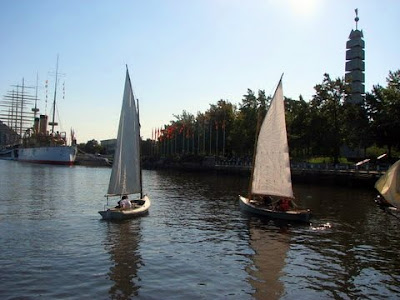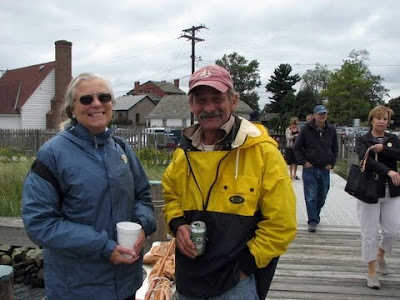

Molly and Erskine Childers sailing Asgard in the Baltic,1910
courtesy Wikipedia

Molly Childers and Mary Spring Rice aboard Asgard bound for Howth
courtesy Echoes of Erin

Arklow Harbor about the time of the build of the boat on whose lines Conor based the Saoirse.
courtesy The Traditional Boats of Ireland Project

Saoirse in the late 1920's, rigged as a staysail schooner
courtesy The Traditional Boats of Ireland Project

The AK Ilen building at the Baltimore Fishery School, Tom Moynihan and crew.
courtesy The Traditional Boats of Ireland Project

Conor and crew, I believe, about to leave for Port Stanley, Falkland Islands, delivering the Ilen
courtesy AK Ilen Company

The Ilen in her new digs at the Hegarty Boatyard, Oldcourt, near Baltimore, Cork...but that's the next story.
courtesy AK Ilen Company
&
Kevin O'Farrell, photographer
I find this an absolutely magnetic story. At it's heart is a true Irish character, Conor O'Brien. Aristocrat, author, naval architect and intellectual, O'Brien was also an Irish patriot and supporter of the Irish rebellion. In 1914 O'Brien in his Kelpie, along with Molly and Erskine Childers in Asgard among others, ran guns for the rebels into Howth harbor in 1914.
Fast forward a few years to 1922 and we find Conor working with the master shipwright Tom Moynihan at the Baltimore Fishery School's boatyard to bring a vision of his to life. That vision was a cruising yacht which was a combination of the traditional and not so traditional. The hull was based on the lines of an old Arklow fishing boat O'Brien had been to sea in, but with more modern accommodations below and a rig designed for ease of handling at sea. Conor's design became Saoirse, (seershuh) gaelic for Freedom in celebration of the new Irish free state. 42' with a 12' beam he seems to have been pleased with his creation. Responding to an invitation from New Zealand, Conor set out in 1923 on a voyage that would bring him to the attention of the yachting world.
"I was invited to join a mountaineering party in the New Zealand Alps at Christmas, 1923, and having a nearly new yacht I regarded this as an excellent opportunity of finding out the merits or demerits of her design, which was of my own making."
The trip to New Zealand became the first leg of a rather bold circumnavigation, rounding the Southern Ocean before returning to Dun Loaghaire, and flying the new Irish Tricolour. Planning his voyage, O'Brien studied the logs of sailing ships from the past, helping him find his way. He made twelve ports of call on his voyage, which took almost exactly two years. This heroic voyage was chronicled by O'Brien in his 'Across Three Oceans'. The book, one of fourteen under his authorship, got the attention of the bluewater cognoscenti at the time. Don Helm, in his informative 'The Circumnavigators' says:
None other than L. Francis Herreshoff said of him: "I consider
O'Brien's books the most masterly analysis of seagoing conditions perhaps ever
written, and even if he and I do not see eye to eye in all matters pertaining to
rig and rigging well, no progress would be made if we all thought alike- but
under no circumstances would I contradict Conor O'Brien for he has had actual
experience." Quoted from the old master's instructions on how to build
Marco Polo, which ran in Rudder magazine, 1946.
On his return leg up the Atlantic, Conor O'Brien and Saoirse called in at the Falkland Islands for a somewhat extended stay. The stopover resulted in the Falklands Islands Company commissioning a larger version of Saoirse, which became, on Conor's return to Baltimore, the AK Ilen.
Construction began in late 1925 under the supervision of Tom Moynihan at the Fisheries school boatyard, Irelands first vocational school. Upon her completion in 1926 Conor pronounced her a 'handsomer model' than the Saoirse. He proceeded to sea trial her around Kerry and the Shannon and ransacked Saoirse for gear. He then set out for the Falklands with two 'Cape Clear' men, arriving in Port Stanley early in 1927, where the boat and crew received a warm welcome. The Ilen was subsequently put to work as a jack of all trades workboat servicing the needs of the islanders for nearly 70 years (!), "working for her living in some of the most demanding waters in the world, ferrying people, school teachers, sheep, stores and mail between the scattered island communities of the Falklands". The Ilen finally retired from worklife in the early 1990's.
In 1997, one keen Irish sailor lamenting the loss of Saoirse in 1979, focused his attention on the Ilen. That was Gary MacMahon. Gary learned the Ilen might be available and with help quickly put together the financing to secure and return her to her birthplace. He founded the AK Ilen Company with Anthony Keane and began planning the Ilen's return. But that, as they say, is another story. (there's more coming)
I'd like to thank a few folks who have been invaluable in starting this series.
First is Kevin O'Farrell, photographer, who put me on to this story and whose invaluable photos of the restoration will be seen later,
Gary MacMahon, who opened the whole can of worms and is still active as the principle of the project,
And Dr. Martin Kay, who spearheads the educational side of the Company and has been exceptionally liberal and forthcoming with information. He's working on grants for writing a book about the Ilen as well as presenting papers on this project and the educational and general status of traditional boatbuilding in Ireland to groups such as Dorna. Martin has promised to send updates as the project progresses.
And the Traditional Boats of Ireland Project, for it's extensive research and some very special photos.
Links:
AK Ilen Company
Big Boat Build Workshops
Traditional Boats of Ireland Project
Don Holm's e-book 'The Circumnavigators'
Wikipedia ConorO'Brien
Wikipedia Howth Gun Running
Wikipedia Erskine Childers
The DORNA Project





































































































